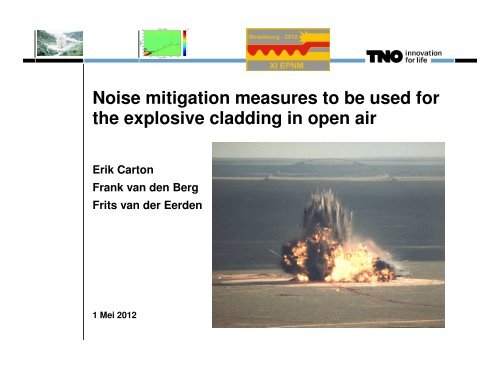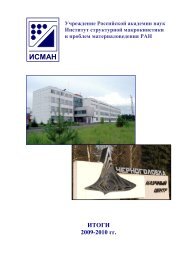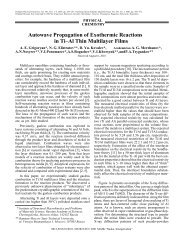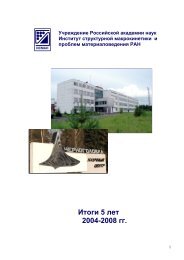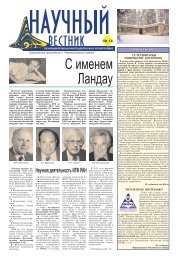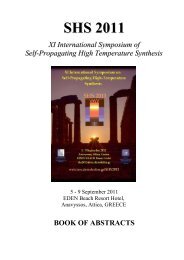Noise mitigation measures to be used for the explosive cladding in ...
Noise mitigation measures to be used for the explosive cladding in ...
Noise mitigation measures to be used for the explosive cladding in ...
- No tags were found...
Create successful ePaper yourself
Turn your PDF publications into a flip-book with our unique Google optimized e-Paper software.
<strong>Noise</strong> <strong>mitigation</strong> <strong>measures</strong> <strong>to</strong> <strong>be</strong> <strong>used</strong> <strong>for</strong><strong>the</strong> <strong>explosive</strong> <strong>cladd<strong>in</strong>g</strong> <strong>in</strong> open airErik Car<strong>to</strong>nFrank van den BergFrits van der Eerden1 Mei 2012
Mitigation Open Air Explosions 1Simulation of <strong>the</strong> blast wave shapeØ 2 m plate of de<strong>to</strong>nat<strong>in</strong>g TNT (0.1 m thick)
Mitigation Open Air Explosions 2Video images of de<strong>to</strong>nation of 50 kg <strong>cladd<strong>in</strong>g</strong> <strong>explosive</strong>without (left) and with water foamFoam:• Reduction <strong>in</strong> peak pressure 28%• Reduction <strong>in</strong> impulse 22%
Mitigation Open Air Explosions 3Overview of presentationObjectiveNumerical techniques & ValidationMuzzle blast <strong>mitigation</strong> (M<strong>in</strong>istry of Defense)Mitigations of open air explosionsConclusions
Mitigation Open Air Explosions 4Objective: Reduction of blast noise from<strong>explosive</strong> <strong>cladd<strong>in</strong>g</strong> <strong>in</strong> open airOpen air explosions burden <strong>for</strong>people <strong>in</strong> <strong>the</strong> surround<strong>in</strong>gsComparable with problems militarytra<strong>in</strong><strong>in</strong>g areaCommon approach not applicable:Shield<strong>in</strong>g <strong>measures</strong> (like <strong>for</strong> traffic) do notworkSound propagation different due <strong>to</strong> highnoise levels (non-l<strong>in</strong>ear effects)
Mitigation Open Air Explosions 5Background: Reduction of “blast” noiseInitialized by:- US-Army- <strong>the</strong> Ne<strong>the</strong>rlands M<strong>in</strong>istry of DefenseObjective: Mitigation of blast noise from large weapons (armor, artillary)- Propagation over large distances- By means of barriers and sound absorb<strong>in</strong>g material- Close <strong>to</strong> <strong>the</strong> source (non-l<strong>in</strong>ear acoustics)gabion or Hesco’s
Mitigation Open Air Explosions 6Numerical hybrid model: FCT – NPE – PEFCT: “Flux-Corrected Transport technique” strong shock waveNPE: “Non-l<strong>in</strong>ear progressive wave equation” weak shock wavePE: “Parabolic Equation” l<strong>in</strong>ear acoustic
Mitigation Open Air Explosions 7Validated at A<strong>be</strong>rdeen Test Centre, MD, USAA large pile of gravel 15x15 m2, 1.5m high, coarse gravel (3cm)Three source locations, C-4 bricks (0.57 kg) 32 … 63 Hz3m1m1.5m-5m+2m
Mitigation Open Air Explosions 8Numerical FCT results (compared <strong>to</strong> measurements)
Mitigation Open Air Explosions 9Case study: Shield<strong>in</strong>g Howitzer blast noise
Mitigation Open Air Explosions 10Case study: Barrier with absorption addedGravel filled gabions/bastions (1 m 3 ):- absorb shock wave energy- suppress ground reflection (<strong>be</strong>h<strong>in</strong>d barrier)
Mitigation Open Air Explosions 11Case study: Barrier with absorption addedTwo movies: blast <strong>mitigation</strong> <strong>be</strong>h<strong>in</strong>d barrier
Mitigation Open Air Explosions 12Calculation results <strong>for</strong> different configurations
Mitigation Open Air Explosions 13A balcony construction <strong>for</strong> <strong>in</strong>creased reduction
Mitigation Open Air Explosions 14Numerical results (sound exposure level, <strong>in</strong> dB)With balcony
Mitigation Open Air Explosions 15Study <strong>to</strong> reduce open airexplosions from <strong>cladd<strong>in</strong>g</strong>“Absorb<strong>in</strong>g” material(broken s<strong>to</strong>nes)
Mitigation Open Air Explosions 16Simulations: 8 variants (500 kg source)Variant 0 = slope without gabionsVariant 1a, 1b = slope with 1m high gabionsVariant 2a,2b,2c = slope with 2m or 3m high gabionsVariant 3a,3b = barrier <strong>in</strong> front of slopeVariant 4, comb<strong>in</strong>ation 3b & 2cvariant2bmicrophones at 80mslope
Mitigation Open Air Explosions 17Levels at end of slope (at 80m, 1/5/10/20m high)Variant0: 12000 PaVariant2b: 6000 PaResult: 6 dB (20log2)Measurement at 90m: 174 dBSimulation at 80m: 176 dB
Mitigation Open Air Explosions 18Levels at 300m (<strong>be</strong>yond slope)Small effects <strong>for</strong> all variants! No noticable effect of <strong>mitigation</strong> <strong>measures</strong>
Mitigation Open Air Explosions 19Explanationvariant2bAt 80m: variant0 12000 Pa, variant2b 6000 PaAt 90m: variant0 6000 Pa, variant2b 5000 Pa propagation <strong>in</strong><strong>to</strong> “shadow zone”, easy <strong>for</strong> low frequenciesshadowvariant2b, already smooth wave with low-frequency content (higher freq’s are damped)variant0, only low-frequencies propagate <strong>in</strong><strong>to</strong> shadow zoneVariant0Variant2b
Mitigation Open Air Explosions 20Balcony results: <strong>in</strong>creased screen<strong>in</strong>g
Mitigation Open Air Explosions 21Balcony results: <strong>in</strong>creased screen<strong>in</strong>g
Balcony results at 300 mMitigation Open Air Explosions 22
Mitigation Open Air Explosions 23ConclusionsHybrid FCT-NPE-PE method presented <strong>for</strong> shock wave propagation non-l<strong>in</strong>ear <strong>in</strong>teraction with barrier / absorb<strong>in</strong>g material;Standard barrier has limited effect <strong>for</strong> explosions;Add<strong>in</strong>g absorb<strong>in</strong>g material <strong>in</strong>creases shield<strong>in</strong>g effect;For strong explosions special constructions (balcony) are needed <strong>to</strong><strong>in</strong>crease barrier effect significantly.


